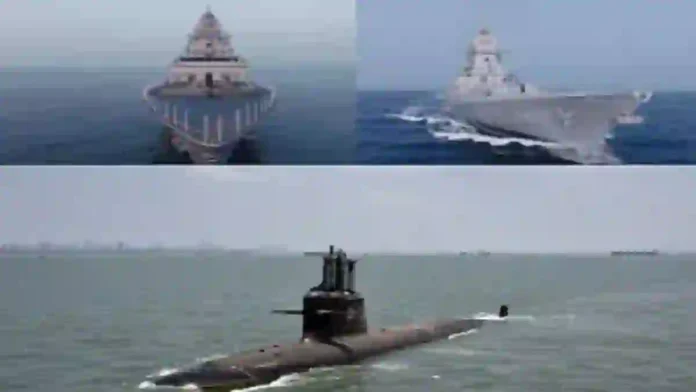In a historic development, Prime Minister Narendra Modi on Wednesday (15 January) simultaneously commissioned three major combat platforms into the Indian Navy.
Three combat ships that were launched include Nilgiri, the lead ship of the Project 17A stealth frigate class; Surat, the fourth and final ship of the Project 15B stealth destroyer class; and Vagsheer, the sixth and final submarine of the Scorpene-class project.
The event, taking place at the Naval Dockyard in Mumbai, is expected to underscore India’s growing self-reliance in defence manufacturing.
All three platforms have been indigenously designed and built by Mazagon Dock Shipbuilders Limited (MDL), Mumbai.
Advancements in Warship Design and Capabilities
The Nilgiri frigate represents a significant technological leap over its predecessor, the Shivalik-class, with state-of-the-art stealth features and a reduced radar signature.
Similarly, the Surat destroyer brings substantial improvements over the Kolkata-class ships, marking the culmination of the Project 15B series.
Both warships were designed by the Indian Navy’s Warship Design Bureau and come equipped with sophisticated weapon systems and sensors developed indigenously or through collaborations with global manufacturers.
These ships are also equipped with modern aviation facilities capable of operating helicopters such as the Chetak, ALH, Sea King, and MH-60R during both day and night operations.
Features like the Rail-Less Helicopter Traversing System and Visual Aid and Landing System ensure seamless functionality under varied conditions.
Read- HAL May Showcase Innovative Combat Air Teaming System (CATS) At Aero India 2025
Furthermore, the ships include accommodations tailored for women officers and sailors, aligning with the Navy’s strides toward gender inclusion in combat roles.
Versatility of the Vagsheer Submarine
The Vagsheer submarine, the last in the Scorpene-class under Project 75, is among the most advanced diesel-electric submarines in the world.
Designed for versatility, it can perform a wide range of missions, including anti-surface and anti-submarine warfare, intelligence gathering, area surveillance, and special operations.
The submarine is armed with wire-guided torpedoes, anti-ship missiles, and advanced sonar systems.
It also features modular construction, allowing for future upgrades, such as the integration of Air Independent Propulsion (AIP) technology.
Agencies




